Semantics based biomedical knowledge search, integration and discovery
During his talk, Professor Barend Mons will talk about the role of semantic technologies, (under)standards and the nanopublication ecosystem in particular. He will challenge several established views in the field of the semantic web, scholarly communication, intellectual networking, science metrics, peer review and ‘data publishing’ with an emphasis on the barriers to break down in order to allow effective data exposure, sharing and integration in the Big Data era. The context of his talk will be the need for eScience approaches to ‘in silico’ knowledge discovery.
Barend Mons holds a chair in Biosemantics at the LUMC and is one of the scientific directors of NBIC. In addition he acts as a Life Sciences 'eScience integrator' in the Netherlands eScience centre. Currently, he coordinates the creation of the DTL Data programme and in that capacity he is also the scientific representative of The Netherlands in the interim board of the ELIXIR ESFRI project. Barend is also participates in Data FAIRport.
The Craftsperson and The Scholar: Research Software Engineers and their place in the university
Dr James Hetherington
Dr Hetherington is a research software engineer, who combines the skills and experience of a computational scientist with those of a professional software engineer. As leader of UCL's Research Software Development team, he works with researchers to produce maintainable, usable, well-tested scientific software that will have a lasting impact. Dr Hetherington holds a PhD in Theoretical Physics.
Moving ICT support towards the fourth paradigm
This presentation will focus on the demand from researchers for ICT support and the shift ICT leaders need to make towards staying relevant. ICT leaders who don’t support research will become a barrier for their organisations and researchers.
Sakkie Janse van Rensburg
eResearch at the UFS: A Decade of (E)nhancing Research
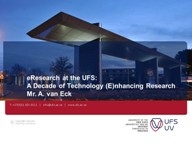
Albert van Eck
Mr. Albert van Eck is the Director of the High Performance Computing Unit at the University of the Free State. He has been involved with HPC since 2005 and started the first POC at the UFS in 2006 with support from Mr Sakkie Janse van Rensburg. In 2007, a special interest group was formed at the UFS and is still active today. In 2008, Albert joined the SAGrid technical team to support research across SA. Since 2008, Van Eck focused on HPC and presented a number of systems administration and GNU Linux training workshops. In 2011, he left the UFS briefly to join the CHPC. In 2012, he returned to the UFS to form the HPC Unit.
Content licensing as a key mechanism for collaboration
The Internet and new collaborative technologies have changed the way we produce and disseminate content. Within this context seamless access to information is a key driver of scientific development. eResearch infrastructures provide the means to transfer digital objects, data and code across geographical boundaries, but closed forms of copyright management still constitute a significant legal barrier to free and open exchange. This presentation will provide a beginner’s introduction to Creative Commons licencing and highlight the affordences of open licencing in an eResearch framework.
Michelle Willmers
DSpace-CRIS: an Open Source solution for Research Presentation Submissions
The Research Area is a complex world to manage:
- collecting data on publications;
- supporting researchers in their daily activities;
- helping administrators to monitor results and to efficiently allocate resources;
- enhancing visibility and strengthening national and international collaborations; and
- providing advanced reporting tools to evaluators.
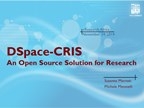
Cineca, in collaboration with the Hong Kong University, started working in 2009 to fill this gap. The result of such international cooperation has been the release of an open source solution (free download available at https://github.com/Cineca/DSpace) called DSpace-CRIS: a mixed repository-CRIS platform that combines the agile OA content management provided by DSpace with additional CERIF-compliant CRIS features built on top (such as persons, organisations and projects). This means that DSpace-CRIS allows an Institution to easily collect and disseminate data and information about researchers, which results in a better promotion of their activities and an enhancement in visibility for the Institution.
Susanna Mornati
Head of Research and International Affairs, she is responsible for IT projects and services for research since 2010. She has strong experience in project and program management in complex environments. She participates as an expert in the activities of several committees and serves on a number of international scientific boards. She writes and lectures on various aspects of IT management for research.
Main previous positions include being responsible for e-publishing and digital repositories services at CILEA (2003-2009), Vice Director of Libraries at the University of Insubria (2002-2003), Director of the Physics Library at the University of Milan (1996-2001), Associate at CERN Scientific Information Service, Geneva, Switzerland, (1994-1996).
She has a Masters degree in Linguistics at the University of Milan, Postgraduate Master, II level, in Information& Communication Technology Management at the University of Milan Bicocca, Diplôme de Langue de l'Alliance Française, English Certificate of Proficiency.
Andrea Bollini
Andrea is a member of the release team and a long-term DSpace committee member. He has been directly involved in the development of the major functionalities as the JSPUI redesign. He works at CINECA, a registered DuraSpace Service Provider based in Italy that, among other activities, provides professional services and IT solution for the Research Management. He is the Product Manager and one of the key Architect of both CINECA’s solutions: the Open Source system (DSpace-CRIS) and the Enterprise edition (IRIS).IRIS uses DSpace as Institutional Repository and DSpace-CRIS as a dissemination module for the other
Research Entities.
Michele Mennielli
Michele is International Relations Manager at Cineca. He represents the Consortium in the Board of Directors of EUNIS (European University Information Systems Association) and he is Deputy Leader of the euroCRIS DRIS/Best Practice Task Group.
UCT’s Research Portal A progress report
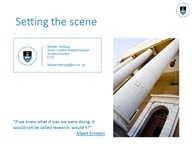
The UCT Researcher Portal is still in its early stages and is very much still under development. Currently, only three of the modules have been completed. These three modules are Researcher Profiles, Scholarly Outputs and Compile CV. These are the focus for this presentation. Two more modules are envisaged for the near future: My Students and My Facilities.
Yvonne Hertzog
Yvonne Hertzog is a Senior Content Analyst/Designer in UCT’s ICTS department. She is the business analyst on the Research Portal project.
Emeritus Associate Professor Andy Duncan
Andrew Duncan retired from UCT in 2008 after 35 years as an academic (Associate Professor in Geochemistry and Geological Sciences) but with 13 of those years also spent managing some major projects at UCT. Now as a consultant to ICTS, he is the program manager for UCT’s Enterprise Content Management program.
e-Research at UCT: the role of strategic partnerships and leadership readiness

As part of the journey towards a robust strategic partnership, leadership readiness within each of the distinct functions of Research Office, Libraries and ICTS was critical to the successful establishment of the e-Research Centre at UCT. The forging of the partnership depended on the willingness of the leadership to shift from a traditional service-centric (function based) to a user-centric approach at institutional level that has capability to integrate multiple service support at relevant points around the research life-cycle.
The paper deals not only with some key achievements of the strategic partnership and leadership in a uni-wide e-Research Centre but it also highlights where it can hurt across implementation, turf contestation and in finding the synergies to shape joint and separate roles and functions across distributed services to meet researcher needs. The use of the RACI chart methodology chart is explained and how it has assisted the leadership to integrate the distinct functions of the Research Office, Libraries and ICTS in a new combination of functions that emerged to support the e-Research Centre at UCT.
Gwenda Thomas, Dr Marilet Sienaert and Sakkie Janse van Rensburg
Design and development of effective web and mobile applications for visualising molecular structure
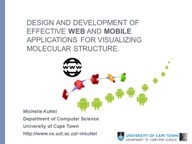
In this talk, I will discuss a range of related student projects that aim to design and develop effective mobile applications for visualizing the structure of carbohydrate molecules. We anticipate that effective mobile applications could be very useful for supporting research collaboration and discussion.
Associate Professor Michelle Kuttel
Michelle Kuttel is an Associate Professor in UCT’s Department of Computer Science. Her rather broad research ranges from using parallel computing methods and hardware to accelerate computationally intensive algorithms in Chemistry and Astronomy, through the development of effective supportive scientific software tools, to the design of effective visualizations for complex scientific data.
Visualisation Walls in Research: More than just big screens and pretty pictures
Visualisation is an effective way of teasing out trends from data, communicating with other scientists and gaining a deeper understanding of a research problem. During this talk, I will reflect on the role a visualisation facility can play in enhancing how researchers can share, manipulate and gain insight into complex data. I will also discuss the hardware and software tools that make this possible. These observations stem from research and experiences gained while utilising the Scientific Computing Research Unit's Visualisation Studio, which is part of the Informatics and Visualisation Lab in the Scientific Computing Research Unit at UCT.
Dr Chris Barnett
Chris Barnett is a Research Officer in the Scientific Computing Research Unit. His research interests lie in the fields of glycomics and visualisation. He is interested in the complexity, structure and function of glycans and their role in disease. He designs workflows, visualisations and analytics tools for exploring and interpreting glycomics datasets.
Highly Immersive Visualization Environment (HIVE)
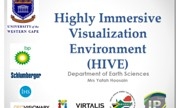
Click here to view the presentation
Yafah Hoosain
Effective visualisation to enhance identification of radio frequency interference in radio astronomy data
The MeerKAT radio telescope, currently being built in the Karoo, will be the largest radio interferometer in the southern hemisphere and among the most sensitive radio telescopes in the world prior to the Square Kilometre Array coming online. There will be 10 large astronomical surveys done with the MeerKAT, focussing on a range of topics from galaxy evolution to pulsars. One of the primary contaminants of radio astronomy data and a challenge for the upcoming surveys is radio frequency interference (RFI) which comes from human-made sources both on the earth and from orbiting satellites. These RFI contaminant signals need to be identified and removed from the telescope data before science analysis can take place.
I will discuss some student projects we have done in collaboration between UCT Astronomy and UCT Computer Science to measure, identify and visualize RFI in radio data from the MeerKAT site.
Sarah-Louise Blyth
Sarah Blyth is a lecturer at UCT in the Department of Astronomy. She is one of the co-Principal Investigators of the upcoming MeerKAT Large Survey, LADUMA (Looking At the Distant Universe with the MeerKAT Array), which will investigate neutral hydrogen in galaxies as a function of cosmic time as a means to study galaxy evolution. She is also interested in the links between Astronomy and Computer Science and the development of algorithms and software to solve problems in Astronomy.
eResearch in Action - Accelerating Knowledge, Enabling Decisions

Dr Kenji Takeda
Dr Kenji Takeda is Solutions Architect and Technical Manager for Microsoft Research. His current focus is helping researchers take best advantage of cloud computing, including through big data and data science approaches, including the Azure for Research programme – www.azure4research.com. He has extensive experience in Cloud Computing, High Performance and High Productivity Computing, Data-intensive Science, Scientific Workflows, Scholarly Communication, Engineering and Educational Outreach. He has a passion for developing novel computational approaches to tackle fundamental and applied problems in science and engineering.
The Centre for High Performance Computing Role within eResearch in South Africa
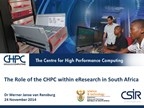
Dr Werner Janse van Rensburg
Dr. Werner Janse van Rensburg is a specialist in Computational Chemistry. He is the Science and Engineering Applications Manager at the Center for High Performance Computing. Prior to this position, Dr. van Rensburg was Manager of Computational Group at SASOL Technologies.
Building infrastructure and capacity to enable genomic research
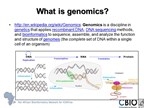
Professor Nicola Mulder
Professor Mulder heads the Computational Biology Group (CBIO) at the University of Cape Town (UCT) (http://www.cbio.uct.ac.za). She graduated with a Bachelor degree, cum laude, in Chemistry and Microbiology, and a first class Honours degree in Microbiology, followed by a PhD in Medical Microbiology. She spent 8 years at the European Bioinformatics Institute (EBI) in Cambridge, where she was a Team Leader, responsible for development of bioinformatics resources for the scientific community. At UCT, Prof Mulder’s research focusses on the bioinformatics of infectious diseases, including pathogen and host genomics and biological networks, human variation and disease association studies. Her group also does training and provides bioinformatics support to researchers. She leads a large NIH-funded consortium, H3ABioNet, to build a Pan-African Bioinformatics network for H3Africa. H3ABioNet is a network of over 30 institutions in 15 African countries and 2 in the USA, which aims to build bioinformatics capacity for genomics research on the continent and develop the infrastructure for managing large-scale genomics data from H3Africa projects.